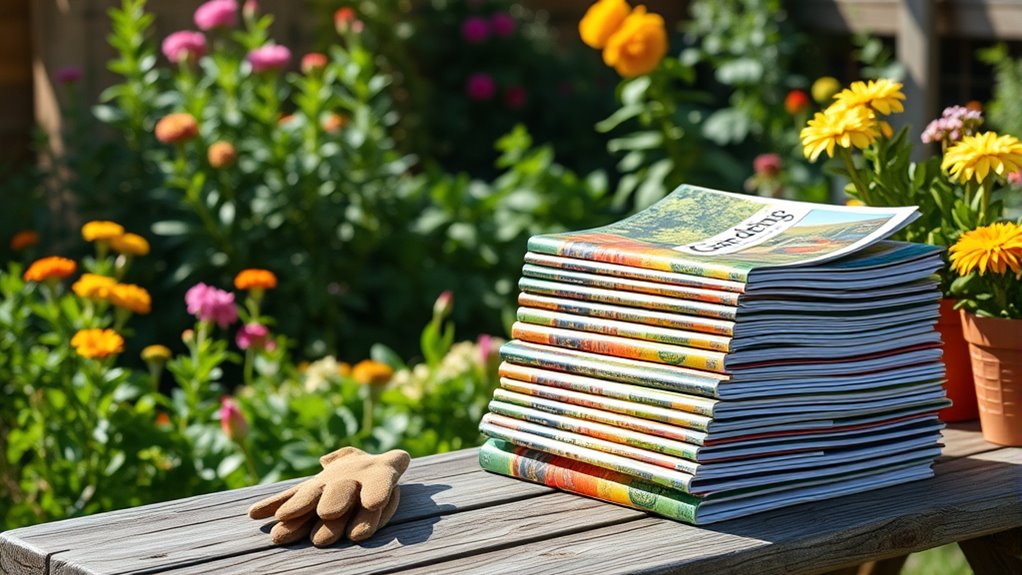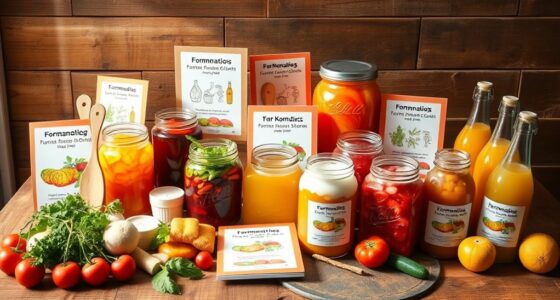If you’re looking to grow your gardening skills in 2025, a great subscription can provide inspiration, practical tips, and stunning visuals. I recommend options like the detailed “Annuals, Perennials, and Bulbs” guide, beginner-friendly “Raised-Bed Gardening,” and hands-on projects in “40 Projects for Building Your Backyard Homestead.” For sustainable food, “Mini Farming” is perfect, and the long-term planning of “Old Farmers Almanac” adds extra value. Keep exploring to find the best fit for your gardening journey.
Key Takeaways
- Top magazines like *Gardentopia* and *Beds & Borders* offer practical design tips and vibrant visuals for gardeners of all levels.
- *Annuals, Perennials, and Bulbs* provides comprehensive flower guides with extensive photos, ideal for enthusiasts seeking detailed plant info.
- *Raised-Bed Gardening for Beginners* and *Mini Farming* cater to newcomers with step-by-step visual instructions and sustainable practices.
- *Old Farmers Almanac* combines long-term planning, weather forecasts, and gardening folklore, suited for seasoned gardeners.
- Consider magazine durability, regional relevance, and updating content for current gardening trends in 2025.
Annuals, Perennials, and Bulbs Book with 377 Flower Varieties
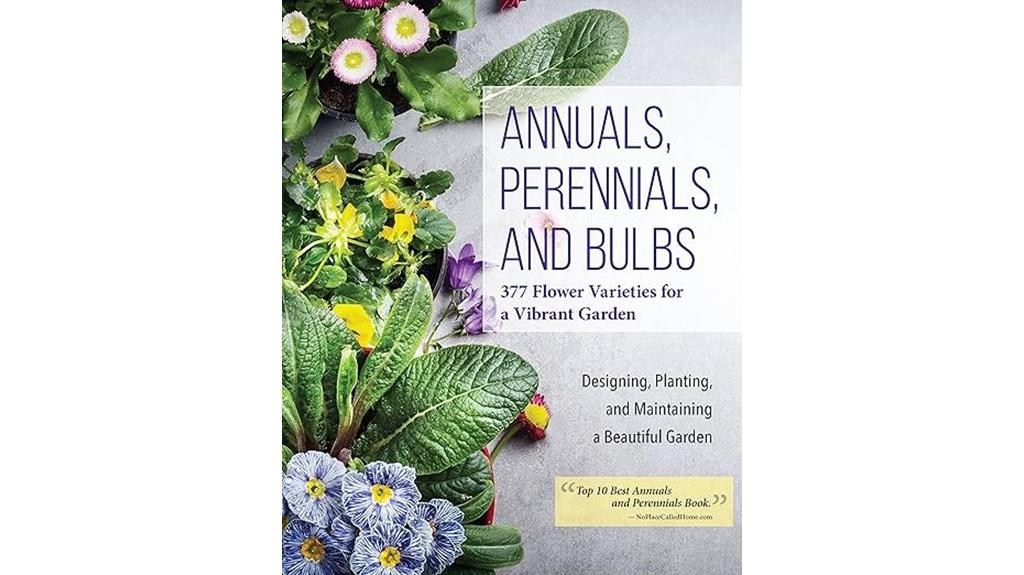
If you’re passionate about creating a vibrant garden and want a reliable resource to guide your planting choices, the “Annuals, Perennials, and Bulbs” book is an excellent choice. It features 377 flower varieties, offering detailed descriptions, planting zones, and propagation tips. With over 600 photos and 40 step-by-step sequences, it’s perfect for beginners and seasoned gardeners alike. The book helps you select the right plants, understand ideal planting times, and troubleshoot common issues. Its clear organization and beautiful visuals make gardening more enjoyable and less overwhelming, empowering you to design and maintain a lush, colorful garden all year round.
Best For: gardeners of all experience levels who want a comprehensive, visually inspiring guide to selecting, planting, and maintaining a diverse range of flowers for a vibrant garden.
Pros:
- Offers detailed descriptions, planting zones, and propagation techniques for 377 flower varieties.
- Contains over 600 high-quality photos and 40 step-by-step sequences, enhancing understanding and inspiration.
- Suitable for both beginners and seasoned gardeners, making it a versatile reference for garden planning and improvement.
Cons:
- Some users wish for more concise charts for quick flower reference and easy access to key information.
- The extensive content may be overwhelming for absolute beginners seeking only basic guidance.
- The physical book’s size and number of pages might be less portable for field use or quick consultations.
Raised-Bed Gardening for Beginners
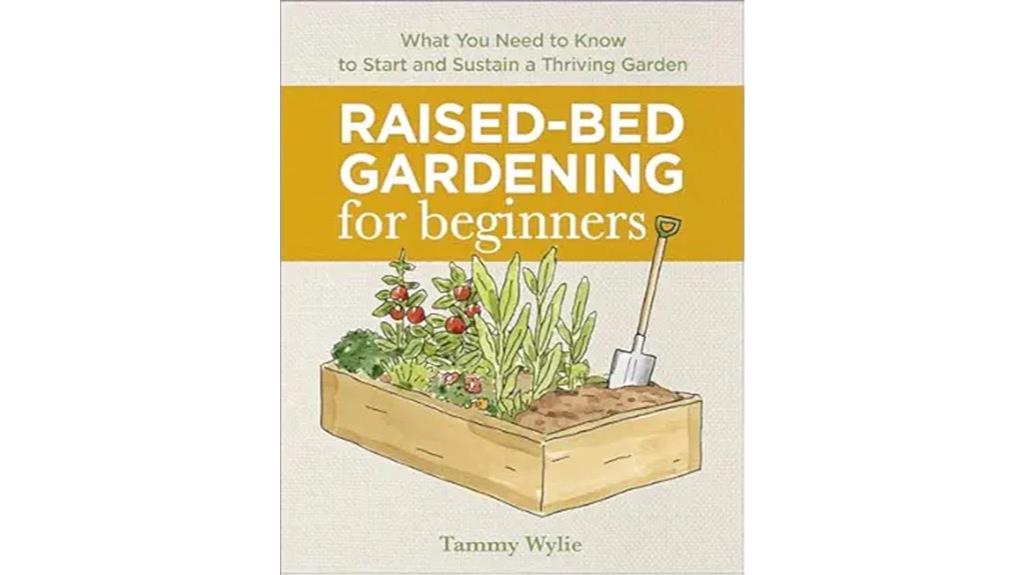
Raised-Bed Gardening for Beginners is an excellent choice for anyone new to gardening who wants a clear, visual guide to start their own vegetable bed. I found this book by Tammy Wylie incredibly helpful, especially as a visual learner. It offers step-by-step advice on planning, planting, and maintaining a small raised bed, with colorful illustrations and practical tips. I used it to set up a 4’x4’ garden, and within three weeks, I saw visible growth. The book emphasizes organization, plant compatibility, and soil basics, making gardening accessible and rewarding for beginners. It’s perfect for those wanting a straightforward, inspiring resource to kickstart their gardening journey.
Best For: beginner gardeners seeking a visual, step-by-step guide to start small raised-bed vegetable gardening with confidence and minimal prior experience.
Pros:
- Clear, colorful illustrations and visual explanations that enhance understanding for visual learners
- Practical, actionable advice on planning, planting, and organization suitable for beginners
- Encourages confidence and sustainability with simple tips for small-scale gardening success
Cons:
- Lacks detailed guidance on fertilization schedules, pest management, and disease control
- Brief coverage of soil amendments and testing may require additional resources for comprehensive soil care
- Some users report physical durability issues, such as the book’s spine coming unglued over time
40 Projects for Building Your Backyard Homestead: A Hands-on, Step-by-Step Sustainable-Living Guide
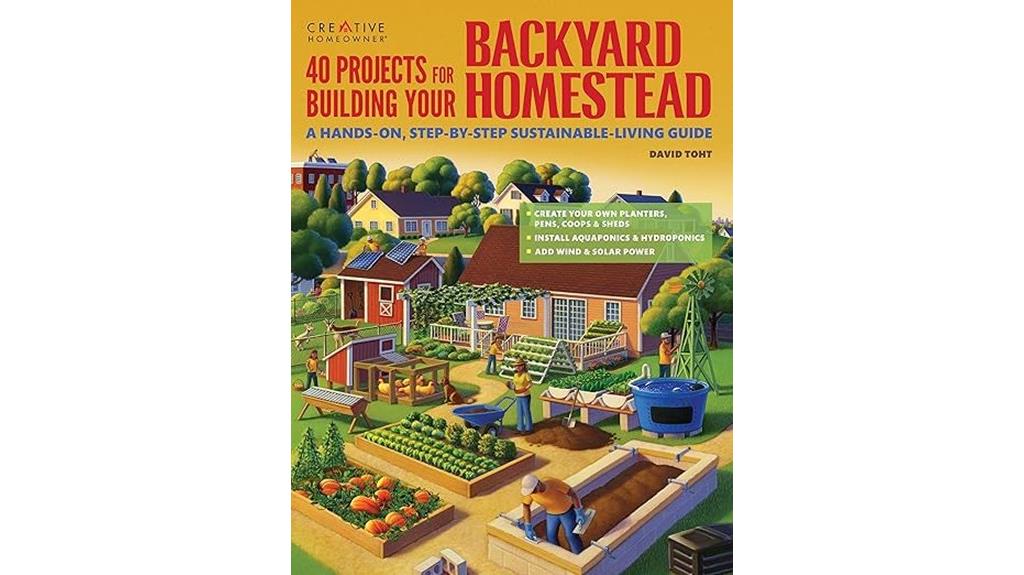
Projects for Building Your Backyard Homestead: A Hands-on, Step-by-Step Sustainable-Living Guide is ideal for beginners and those new to DIY homesteading who want clear, practical instructions. I find this book incredibly helpful because it offers detailed diagrams, step-by-step guides, and easy-to-follow plans for building fences, chicken coops, sheds, and garden beds. It’s perfect if you’re just starting out, emphasizing traditional materials and techniques. While it doesn’t cover complex renewable energy systems, it provides a solid foundation for creating a self-sufficient backyard. This resource can replace multiple guides, making homesteading projects approachable and manageable.
Best For: beginners and DIY homesteaders seeking clear, practical guidance on building essential backyard structures and projects for sustainable living.
Pros:
- Detailed diagrams and step-by-step instructions make projects accessible for novices
- Focus on traditional materials and techniques suitable for a self-sufficient backyard
- Replaces multiple guides with comprehensive project ideas and practical advice
Cons:
- Lacks detailed guidance on renewable energy systems such as solar, wind, or plumbing
- Some projects may seem basic or redundant for experienced homesteaders
- Does not include advanced technical formulas or complex system planning
Mini Farming: Self-Sufficiency on 1/4 Acre
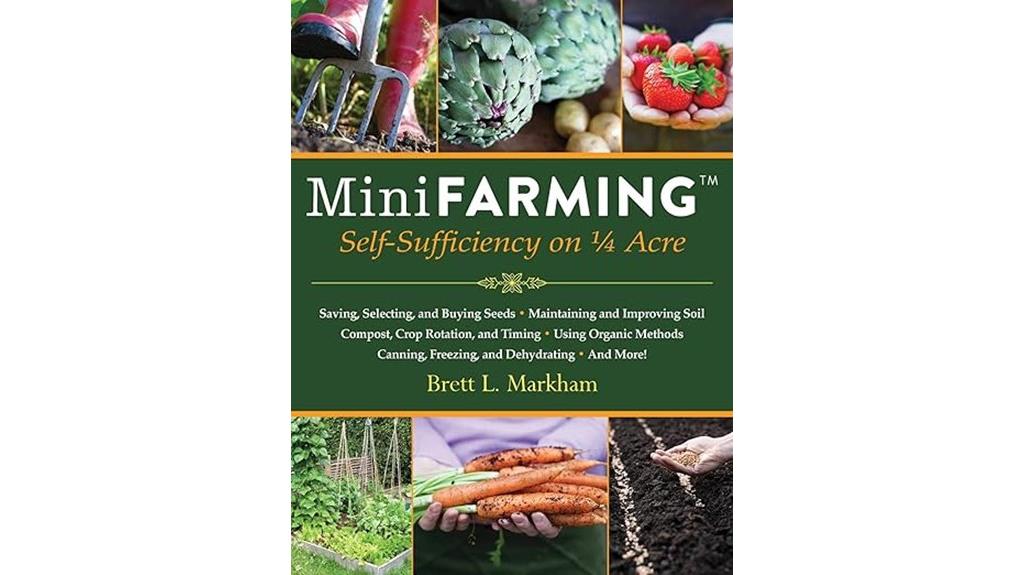
Mini Farming: Self-Sufficiency on 1/4 Acre stands out as an essential resource for small-scale gardeners aiming to maximize limited space. I appreciate how the book offers clear, practical guidance on planning, crop selection, pest control, irrigation, composting, and even raising chickens. It’s perfect for both beginners and experienced gardeners, with detailed charts, real-world examples, and adaptable techniques. While some illustrations could be streamlined, the content remains highly relevant. This book has inspired me to improve my methods, increase my yields, and enjoy sustainable food production on a small plot. It’s a extensive, accessible guide to thriving in limited space.
Best For: small-scale gardeners and aspiring mini-farmers seeking practical, efficient guidance for maximizing limited land for sustainable food production.
Pros:
- Comprehensive and well-organized coverage of gardening, pest management, composting, and chicken raising
- Clear, practical instructions with charts, real-world examples, and adaptable techniques suitable for beginners and experienced gardeners
- Encourages sustainable practices and boosts confidence in small-scale self-sufficiency
Cons:
- Some chapters, like “Time and Yield,” are brief and could benefit from more detailed guidance
- Illustrations sometimes serve as filler, increasing page count without proportional content
- Limited coverage on transmittable chicken diseases and manure pathogens, which could be expanded for poultry keepers
The 2025 Old Farmers Almanac Trade Edition
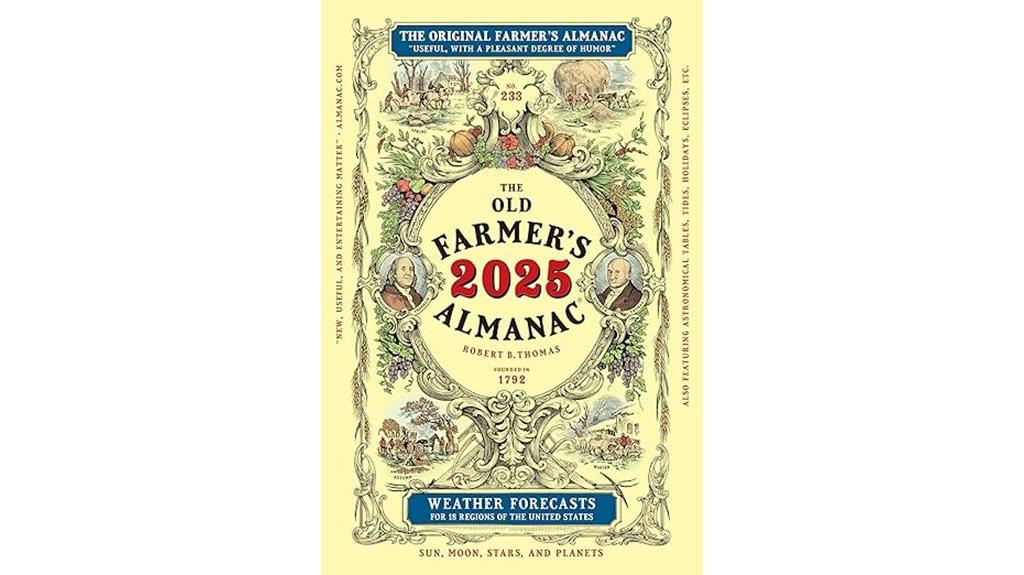
Are you someone who values long-term planning and practical advice for gardening? The 2025 Old Farmers Almanac Trade Edition is a must-have. It offers reliable weather forecasts, planting tips, and pest management strategies that help me plan my garden year-round. I rely on its guidance for ideal planting and harvesting times, along with advice for soil health and crop selection. Beyond the practical, I enjoy its historical anecdotes and folklore, which connect me to tradition and nature. Whether I’m a beginner or seasoned gardener, I find it inspiring and informative—an essential resource that keeps me connected to the land and my roots.
Best For: gardening enthusiasts, both beginners and seasoned growers, seeking reliable long-term weather forecasts, planting advice, and historical insights to enhance their gardening and outdoor planning.
Pros:
- Offers accurate long-range weather forecasts and planting guidance that aid seasonal planning
- Rich in historical anecdotes, folklore, and cultural insights that connect readers to tradition and nature
- Serves as a treasured family heirloom and educational resource, ideal for gifting and family bonding
Cons:
- Occasionally experiences delivery delays or sends editions not region-specific, which may affect usability
- Some users suggest design improvements like color covers or matching sleeves for aesthetic appeal
- The dense content may be overwhelming for casual readers seeking quick information
Gardentopia: Design Basics for Creating Beautiful Outdoor Spaces
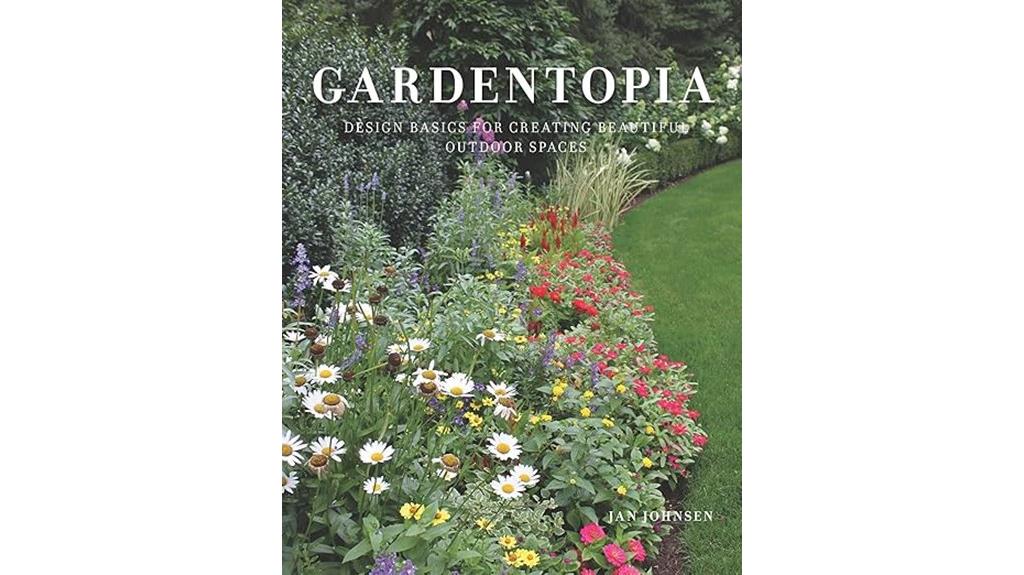
If you’re new to gardening or looking for fresh ideas to enhance your outdoor space, “Gardentopia: Design Basics for Creating Beautiful Outdoor Spaces” is an excellent resource. This vibrant, photo-rich guide offers 110 creative garden ideas, perfect for beginners and seasoned gardeners alike. It emphasizes simple design principles and practical DIY tips that work in various garden sizes. The inspiring visuals encourage experimentation, making it easy to visualize and implement new concepts. Though some ideas may not suit tiny yards, most readers find it a valuable source of inspiration and guidance, helping them craft beautiful, personalized outdoor spaces with confidence.
Best For: beginners seeking visual inspiration and practical ideas to enhance their outdoor gardens, regardless of size or experience level.
Pros:
- Beautiful, vibrant photography that sparks creativity and inspiration
- Concise, clear design principles suitable for various garden sizes
- Practical DIY tips and concepts that can be easily applied
Cons:
- Some ideas may not be suitable for very small or specific garden spaces
- Not a detailed, step-by-step gardening guide, focusing more on design inspiration
- A few readers have noted manufacturing flaws, such as misprinted covers
The Best of Birds & Blooms 2022
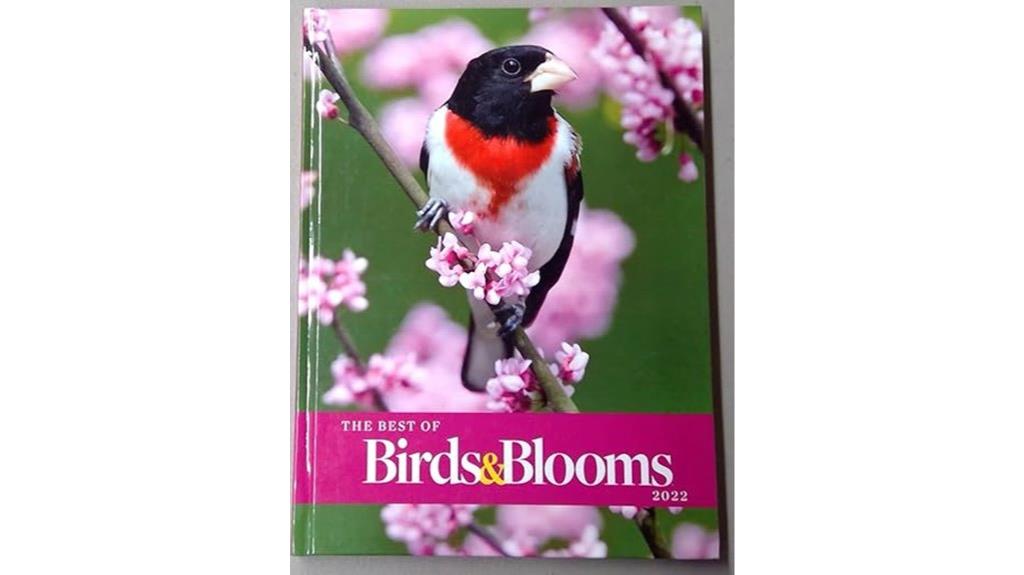
For avid bird watchers and nature lovers, The Best of Birds & Blooms 2022 stands out as an essential resource. I love its stunning photographs paired with informative narratives that deepen my appreciation for birds, butterflies, and plants. It’s a handy reference for identifying local species and understanding their behaviors, inspiring me to create wildlife-friendly gardens. The book offers practical tips on plant choices and yard design to attract hummingbirds and butterflies. Plus, I enjoy its bird photography advice and personal stories. It’s a beautiful, useful guide that fuels my passion for birding and gardening, making it a perfect addition to any nature enthusiast’s collection.
Best For: bird lovers, gardeners, and nature enthusiasts seeking a beautifully illustrated and informative guide to local birds, butterflies, and plants that enhances their outdoor experiences.
Pros:
- Stunning photographs and engaging narratives that deepen appreciation for wildlife.
- Practical gardening tips for attracting birds and butterflies, including plant selection and yard design.
- Supports bird watching, photography, and conservation efforts, making it a versatile resource.
Cons:
- May be less detailed for advanced ornithologists or botanists seeking in-depth scientific data.
- Some users might find the book primarily visual and less technical in nature.
- The focus on North American species may limit usefulness for international wildlife enthusiasts.
The Best of Birds & Blooms 2023
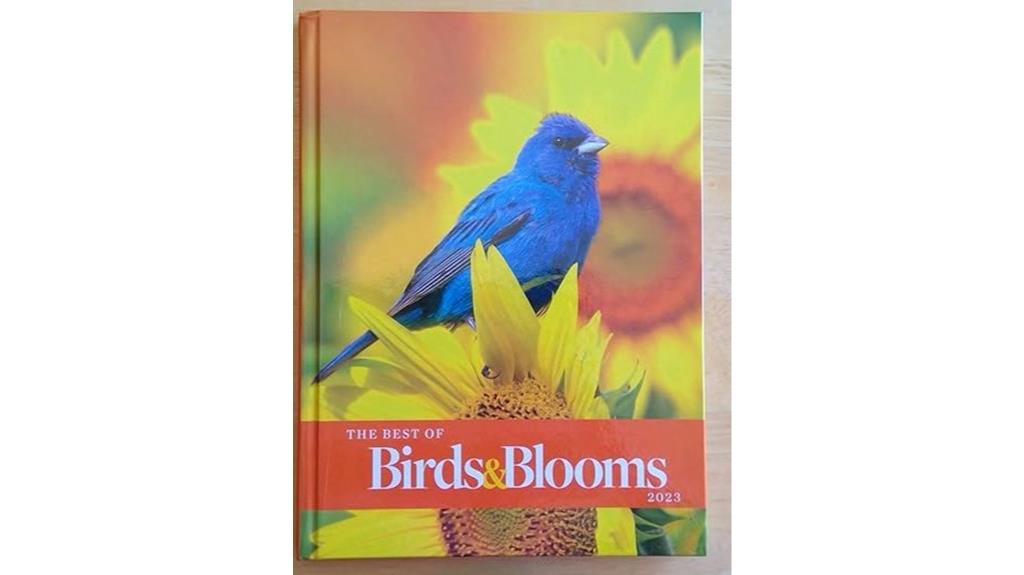
Anyone who loves birds and flowers will find “The Best of Birds & Blooms 2023” to be an exceptional gift or personal keepsake. This beautifully crafted book combines stunning photos with insightful details, making it perfect for bird and gardening enthusiasts. I purchased it for my elderly parents, who cherish birds and flowers but can’t garden anymore. They loved the high-quality visuals, especially since many images are their own. It’s not only a visual delight but also a useful tool for identifying different bird species. The durable, well-made presentation makes it a lasting addition to any nature lover’s collection.
Best For: bird and flower enthusiasts, gardening lovers who can’t garden anymore, and gift buyers seeking a beautiful, informative nature-themed book.
Pros:
- Stunning photographs and insightful descriptions enhance understanding and appreciation of birds and flowers
- High-quality, durable construction ensures longevity and a premium feel
- Ideal as a gift or personal keepsake, appreciated by nature lovers of all ages
Cons:
- May be too visually dense for those preferring minimalistic or text-heavy books
- Limited to bird and flower content, not covering broader gardening or wildlife topics
- Might be costly for those seeking a more budget-friendly nature book
The 2024 Old Farmer’s Almanac Trade Edition (Old Farmers Almanac, 232)

The 2024 Old Farmer’s Almanac Trade Edition is an essential resource for gardening enthusiasts who appreciate traditional wisdom and long-range planning. I’ve always relied on it for weather forecasts, planting guides, and moon phases that influence my garden. Its historical stories and folk practices connect me to simpler times, making gardening feel more meaningful. While some forecasts are broad, I find its seasonal advice and moon-based planting tips useful for planning ahead. Beyond gardening, I enjoy its stories, recipes, and tips on natural remedies. It’s a timeless, practical book that encourages a mindful, traditional approach to living and growing, making it a valued yearly companion.
Best For: gardening enthusiasts, traditional living advocates, and those seeking nostalgic, long-range seasonal guidance.
Pros:
- Offers valuable long-term weather forecasts and planting advice based on moon phases and seasonal trends.
- Rich in historical stories, folk practices, recipes, and natural remedies that connect readers to traditional lifestyles.
- Serves as a practical, timeless resource that promotes mindful, slower-paced living and planning.
Cons:
- Contains numerous advertisements that may distract from the core content.
- Shift from detailed moon calendars to broader date ranges can reduce usefulness for precise planting schedules.
- Weather predictions are not always accurate, with some users rating their reliability as mixed.
Beds & Borders (Better Homes and Gardens Gardening)
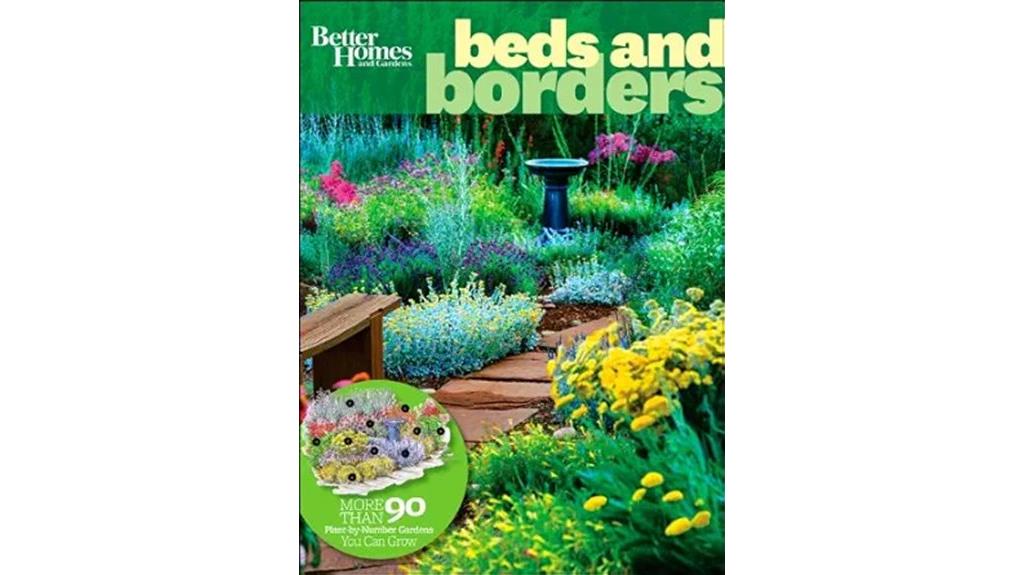
If you’re looking to enhance your landscape design with clear, practical guidance, Beds & Borders from Better Homes and Gardens Gardening stands out as an excellent resource. I’ve found it incredibly helpful for both beginners and intermediate gardeners, offering well-organized, easy-to-understand plans and ideas. The book includes detailed layouts, plant illustrations, and full-color photos that help visualize the final result. Whether you’re working with full sun, partial shade, or shade, it provides adaptable solutions. I appreciate its practical tips for creating beautiful borders and garden zones without breaking the bank. This book truly inspires confident, cost-effective landscaping efforts.
Best For: beginner and intermediate gardeners seeking clear, practical guidance and inspiring landscape design ideas.
Pros:
- Well-organized, easy-to-understand plans and layouts suitable for various skill levels.
- Rich visual aids including drawings, plant illustrations, and full-color photographs that help in visualizing garden results.
- Offers practical, budget-friendly tips for creating beautiful borders and designing diverse garden zones.
Cons:
- Lacks specific details on bloom durations for individual plants.
- May require supplementary resources for advanced landscape design techniques.
- Some users might find the variety of design options overwhelming without prior planning experience.
Super Simple Outdoor Woodworking: 15 Practical Weekend Projects

Looking to tackle outdoor woodworking projects over the weekend? “Super Simple Outdoor Woodworking: 15 Practical Weekend Projects” stands out as an excellent resource for beginners and hobbyists enthusiastic to craft functional, attractive outdoor items. The book features clear instructions, detailed step-by-step guides, and durable quality, making it perfect for small garden projects, repurposing pallets, or creating personal outdoor spaces. It’s highly praised for its practicality and variety, appealing to those new to woodworking or looking for fun weekend endeavors. Whether you’re building a garden bench or a decorative piece, this book helps you complete projects confidently and enjoyably.
Best For: DIY enthusiasts, beginners, and hobbyists looking for straightforward outdoor woodworking projects to complete over weekends.
Pros:
- Clear, step-by-step instructions suitable for beginners.
- Durable quality and well-illustrated content enhance the woodworking experience.
- Offers a variety of projects for outdoor use, garden, and creative repurposing.
Cons:
- May lack advanced techniques for experienced woodworkers.
- Focuses primarily on small projects, limiting larger-scale woodworking ideas.
- Some readers might find the project complexity varies, requiring additional tools or skills.
The Best of Birds & Blooms 2006

Are you passionate about birds and gardening, seeking a way to combine both interests seamlessly? “The Best of Birds & Blooms 2006” is an excellent choice for enthusiasts who want to enjoy expert tips alongside stunning visuals. This hardcover collection features beautiful, high-quality images that bring the topics to life. Inside, you’ll find useful tips and ideas from the past year, making it a valuable resource. Customers praise its excellent quality, fast delivery, and the joy of browsing through gorgeous pictures. Whether you’re a seasoned gardener or bird lover, this book offers inspiration and practical advice to enrich your outdoor experience.
Best For: bird and gardening enthusiasts seeking beautiful visuals combined with expert tips to enhance their outdoor spaces.
Pros:
- High-quality, stunning images that bring bird and garden topics to life
- Contains practical tips and ideas from the past year for immediate use
- Durable hardcover with glossy pages, making it a collectible and enjoyable read
Cons:
- Limited to content from 2006, which may feel somewhat dated for some users
- Might not include the latest trends or recent advancements in birding and gardening
- As a hardcover, it could be less portable for casual outdoor use
Better Homes and Gardens Rose Gardening
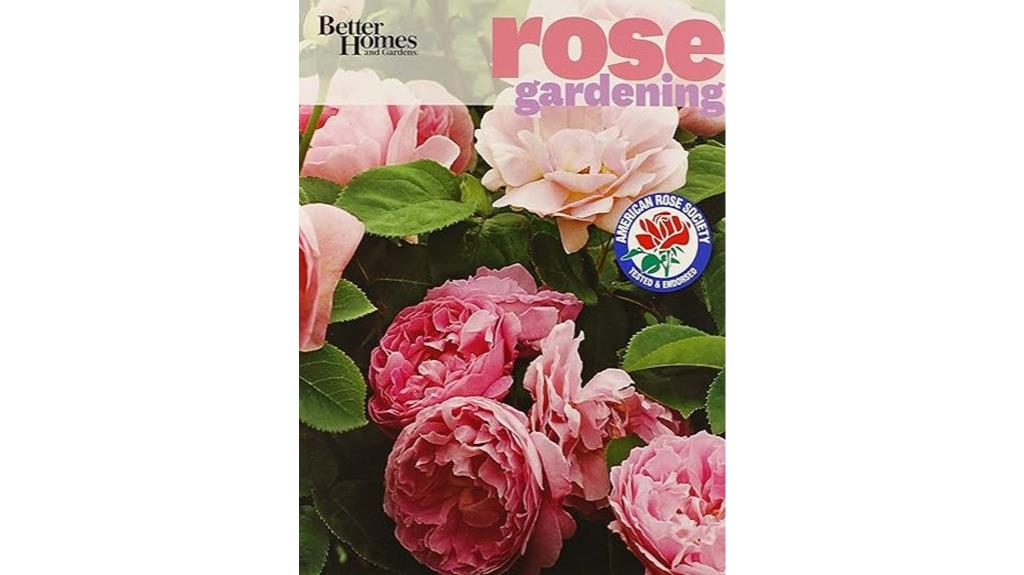
For garden enthusiasts passionate about roses, Better Homes and Gardens Rose Gardening stands out as an ideal resource. It offers clear, modern guidance suitable for both beginners and seasoned gardeners, covering soil, pruning, and rose care. The book features a stunning gallery of colorful roses and landscaping ideas, making it visually inspiring. While it doesn’t explore deeply into pest and disease management, it provides practical tips and background on rose history and symbolism. With high-quality photos and concise descriptions, it enhances both aesthetic appreciation and gardening knowledge. Plus, it includes a subscription to Better Homes and Gardens magazine, making it a worthwhile addition to any rose lover’s collection.
Best For: garden enthusiasts of all levels who are passionate about roses and seeking a visually inspiring and practical gardening resource.
Pros:
- Beautiful, high-quality color photographs and landscaping ideas that inspire creativity.
- Clear, modern guidance suitable for both beginners and experienced gardeners.
- Provides background on rose history, symbolism, and general care tips, plus a subscription to Better Homes and Gardens magazine.
Cons:
- Lacks detailed coverage on pest and disease management, making it less comprehensive for plant health issues.
- Limited focus on troubleshooting specific rose pests and fungal problems.
- May not satisfy those looking for an in-depth, technical guide on rose pests and disease treatments.
Homemade, best made (Readers Digest General Books)
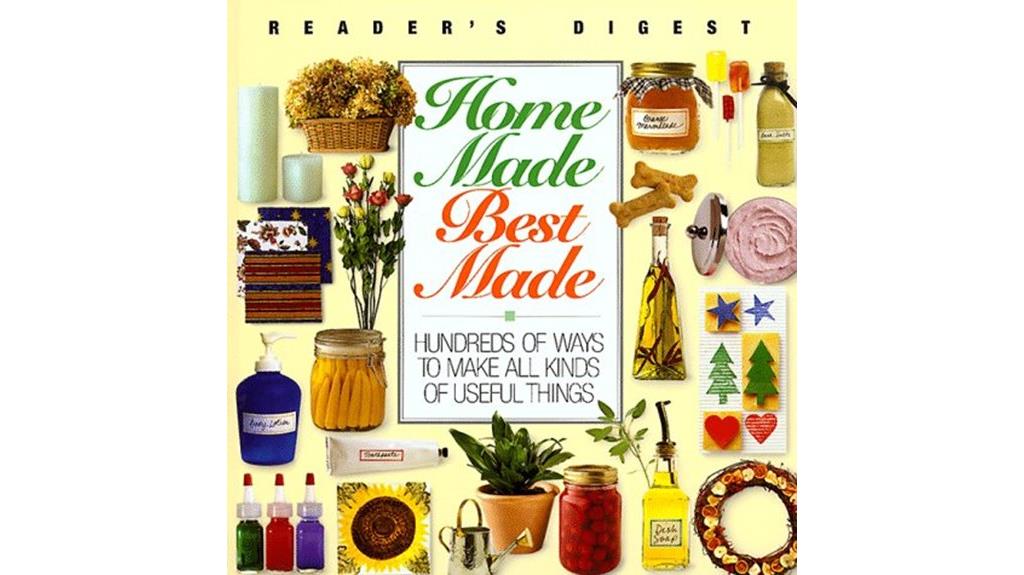
If you enjoy hands-on projects, homemade recipes, and crafting, the “Homemade, best made” section in Readers Digest General Books offers invaluable guidance. This beloved classic has been a personal keepsake for over 22 years, sharing timeless recipes for sauces, jams, desserts, and DIY household items like cosmetics and cleaning products. It encourages making things from scratch with natural ingredients, saving money, and ensuring quality. The book also covers home decorating and gardening projects, fostering creativity and self-sufficiency. Despite being out of print, it remains relevant, inspiring generations to craft, cook, and garden with confidence and resourcefulness.
Best For: DIY enthusiasts, home cooks, and crafters seeking practical, timeless projects and recipes to enhance self-sufficiency and creativity at home.
Pros:
- Offers a wide range of recipes and craft ideas suitable for all skill levels.
- Emphasizes natural ingredients, safety, and cost-saving techniques.
- Provides inspiration for home decorating, gardening, and family projects.
Cons:
- Some content may be outdated due to evolving lifestyles and technology.
- Limited availability as the book is out of print, making physical copies harder to find.
- Focuses primarily on traditional methods, which may not align with modern organic or eco-friendly trends.
Factors to Consider When Choosing Gardening Magazine Subscriptions
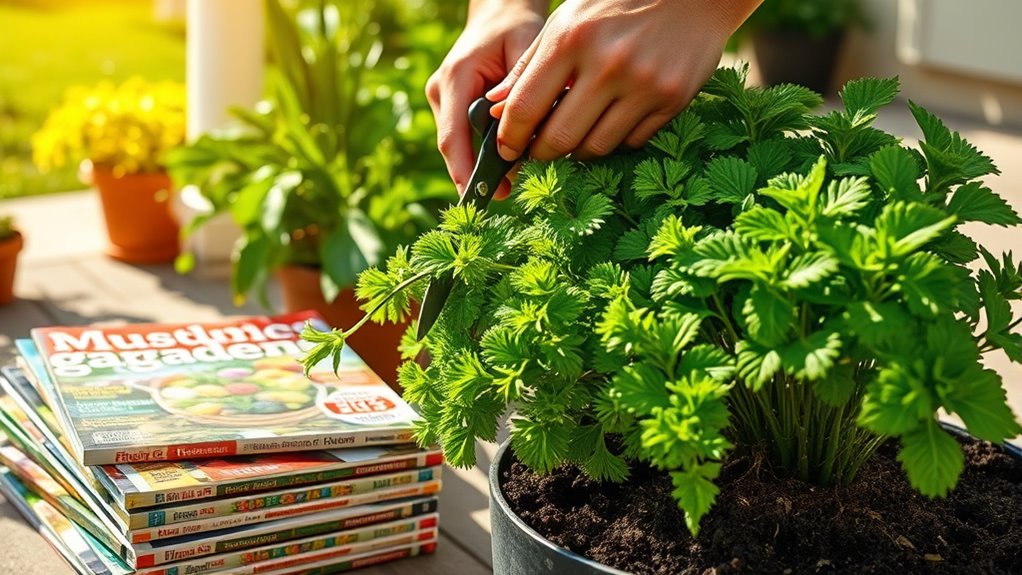
When choosing a gardening magazine, I focus on how well the content matches my interests and skill level. I also consider the magazine’s visual appeal and how often it’s published, so I stay inspired throughout the year. Cost and audience suitability are important too, ensuring I get value and relevant tips for my gardening style.
Content Relevance
Ever wondered how to pick a gardening magazine that truly matches your interests? The key is ensuring the content aligns with your specific gardening passions, whether that’s vegetable gardening, flower arranging, or landscape design. Check if the magazine covers your USDA hardiness zone so you get region-specific advice. It’s also important that the magazine offers practical tips, step-by-step guides, and visual aids suited to your skill level and goals. Look for publications that feature current, research-based information rather than outdated advice. Additionally, consider if the content focuses on plants, techniques, and seasonal topics relevant to your local climate and environment. This way, the magazine becomes a valuable resource tailored to your unique gardening needs, helping you grow with confidence and knowledge.
Visual Appeal
Have you noticed how vibrant photographs and clean layouts can make a gardening magazine more inviting and inspiring? High-quality, colorful images bring gardens to life and spark creativity. Clear, well-organized layouts help me quickly find the ideas I’m after, whether it’s planting tips or landscape designs. Visually distinct sections make browsing effortless and enjoyable. I also appreciate detailed photos and illustrations of plants, flowers, and landscapes—they help me visualize techniques and expected results. A magazine’s aesthetic presentation, including its cover design and page layout, plays a big role in its attractiveness and my overall reading experience. When the visual appeal is strong, it motivates me to stay engaged and inspired to try new gardening projects. It’s an essential factor in choosing a magazine I’ll enjoy and learn from.
Subscription Cost
Choosing a gardening magazine isn’t just about the content; the subscription cost plays a significant role in my decision. Prices can vary widely, from under $10 to over $50 annually, depending on the publication and subscription length. I look for discounts on multi-year subscriptions or bundle deals, which can save money over time. Digital versions are usually more affordable than print, so I consider which format fits my budget and preferences. I also check for any additional costs, like special issues or premium content, that could increase the price. Importantly, I compare renewal rates and look for introductory offers to avoid surprises later. Balancing quality content with affordability helps me choose a magazine that’s both enjoyable and budget-friendly.
Audience Suitability
When selecting a gardening magazine, it’s crucial to take into account the reader’s experience level to make certain the content matches their skills. Beginners need straightforward advice and step-by-step instructions, while seasoned gardeners might prefer in-depth techniques or advanced tips. I also consider the reader’s climate and regional gardening needs—choosing magazines that cover plants and pests specific to their zone makes a big difference. Interests matter too; someone passionate about floral design will want a different focus than a vegetable grower or wildlife enthusiast. Additionally, I think about the reader’s demographic, such as age or lifestyle, to recommend publications that align with their gardening goals. Matching a magazine’s style and focus ensures the content is engaging, relevant, and truly helpful.
Publication Frequency
Publication frequency plays a significant role in how well a gardening magazine fits your needs. Monthly issues deliver fresh tips, trends, and seasonal advice, perfect if you want ongoing inspiration and current information. If you prefer more in-depth content, quarterly publications offer detailed articles and exhaustive guides, ideal for long-term planning. Annual magazines focus on overarching themes and major seasonal insights, providing a broader perspective with less frequent updates. The choice depends on how often you want new content—more frequent issues keep you aligned with planting seasons and weather patterns, while less frequent publications suit those who enjoy deeper dives without constant updates. Consider your gardening style and how regularly you want to stay informed when selecting the right publication frequency.
Frequently Asked Questions
How Do Magazine Subscriptions Enhance Practical Gardening Skills?
Magazine subscriptions improve my practical gardening skills by providing fresh ideas, expert advice, and new techniques right to my doorstep. I stay updated on seasonal tips and common problems, which helps me troubleshoot and experiment confidently. The vibrant images and detailed tutorials inspire me to try new plants and methods, making gardening more enjoyable and successful. Overall, they’re a valuable resource that keeps my green thumb sharp and my garden thriving.
Can Subscriptions Provide Tailored Gardening Advice for Specific Climates?
Absolutely, magazine subscriptions can seem like magic wands, offering tailored advice for your unique climate. I’ve seen them transform my gardening game, providing hyper-specific tips that save me from costly mistakes. The best magazines analyze local weather patterns, soil types, and seasonal challenges, giving me practical, personalized guidance. If you want your garden to thrive no matter where you are, subscribing is like having a personal horticulturist in your mailbox.
Do Magazines Include Access to Exclusive Gardening Workshops or Events?
Yes, many gardening magazines include access to exclusive workshops or events. I’ve found that subscribing often grants me invites to special gardening seminars, webinars, or local meetups organized by the publishers. These events are a fantastic way to learn new skills, connect with fellow enthusiasts, and get expert advice firsthand. If you’re looking to deepen your gardening experience, choosing a magazine that offers these exclusive opportunities can be incredibly rewarding.
Are Digital Editions of Gardening Magazines More Beneficial Than Print?
I think digital editions are more beneficial because they’re convenient and eco-friendly. I love accessing magazines on my tablet or phone, so I can read anytime, anywhere. Plus, digital issues often include interactive content, videos, and links to resources I can’t find in print. However, I still appreciate the tactile feel of print for relaxing gardening inspiration. It really depends on what matters most to you.
How Often Do Gardening Magazines Update Their Seasonal Planting Guides?
Most gardening magazines update their seasonal planting guides four times a year, aligning with each season. I love how these updates keep me informed about ideal planting times, new trends, and tips tailored to the current climate. Some magazines also include monthly tips or special editions, so I always have fresh, relevant advice at my fingertips. It’s a great way to stay inspired and guarantee my garden flourishes year-round.
Conclusion
Choosing the right gardening magazine is like selecting the perfect plant—you want something that nurtures your passion and grows with you. Whether it’s a guide to vibrant annuals or a step-by-step homestead project, each subscription offers a unique seed of inspiration. In cultivating your green thumb, remember that patience and variety matter more than instant results. After all, the most beautiful gardens bloom over time, just like the most rewarding journeys.
